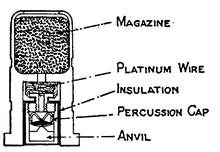brass cones which are connected by a wire “bridge” of platinum silver. This bridge is surrounded by a priming composition of gun-cotton dust and mealed powder and the remainder of the tube is filled with powder. On an electric current passing, the bridge is heated to incandescence and ignites the priming composition.

|
Fig. 18.—Primer. |
In the wireless tube (fig. 17) the lock of the gun makes the electric contact with an insulated disc in the head of the tube. This disc is connected by an insulated wire to a brass cone, also insulated, the bridge being formed from an edge of the cone to a brass wire which is soldered to the mouth of the tube. Priming composition surrounds the bridge and the tube is filled with powder. The electric circuit passes from the gun lock to the disc, thence through the bridge to the body of the tube, returning through the metal of the gun and mounting.
The percussion tube (fig. 18) has a similarly shaped body to the wireless electric tube, but the internal construction differs; it is fitted with a striker, below which is a percussion cap on a hollow brass anvil, and the tube is filled with powder.
With Q.F. guns (that is, strictly, those using metallic cartridge cases) the case itself is fitted with the igniting medium; in England these are called primers. For small guns the case contains a percussion primer, usually a copper cap filled with a chlorate mixture and resting against an anvil. The striker of the gun strikes the cap and fires the mixture. For larger guns an electric primer (fig. 19) is used, the internal construction and action of which are precisely similar to the wireless tube already described; the exterior is screwed for the case. For percussion firing an ordinary percussion tube is placed in an adapter screwed into the case. In some foreign services a combined electric and percussion primer is used; the action of this will be understood from fig. 20.

|
Fig. 19.—Electric Primer. |
The first cartridges for cannon were made up of gunpowder packed in a paper bag or case. For many years after the introduction of cannon the powder was introduced into the bore by means of a scoop-shaped ladle fixed to the end of a long stave. The ladle was made of the same diameter as the shot, and it had a definite length soCartridges. that it was filled once for the charging of small guns but for larger guns the ladle had to be filled twice or even thrice. The rule was to make the powder charge the same weight as that of the shot.

|
Fig. 20.—Combined Primer. |
Cartridges made up in paper or canvas bags were afterwards used in forts at night-time or on board ship, so that the guns could be more rapidly loaded and with less risk than by using a ladle. Before loading, a piece of the paper or canvas covering had to be cut open immediately under the vent; after the shot had been rammed home the vent was filled with powder from a priming horn, and the gun was then fired by means of a hot iron, quick match or port-fire.
The ancient breech-loading guns were not so difficult to load, as the powder chamber of the gun was removable and was charged by simply filling it up with powder and ramming a wad on top to prevent the escape of the powder.
Paper, canvas and similar materials are particularly liable to smoulder after the gun has been fired, hence the necessity of well sponging the piece. Even with this precaution accidents often occurred owing to a cartridge being ignited by the still glowing débris of the previous round. In order to prevent this, bags of non-smouldering material, such as flannel, serge or silk cloth are used; combustible material such as woven gun-cotton cloth has also been tried, but there are certain disadvantages attending this.
All smokeless powders are somewhat difficult to ignite in a gun, so that in order to prevent hang-fires every cartridge has a primer or igniter, of ordinary fine grain gunpowder, placed so as to intercept the flash from the tube; the outside of the bag containing this igniter is made of shalloon, to allow the flash to penetrate with ease. The charge for heavy guns (above 6 in.) is made up in separate cartridges containing half and quarter charges, both for convenience of handling, and to allow of a reduced charge being used.

|
Fig. 21.—10-inch B.L. Gun Cartridge. |
The cartridges are made of a bundle of cordite, or other smokeless powder, tightly tied with silk, placed in a silk cloth bag with the primer or igniter stitched on the unclosed end; the exterior is taped with silk cloth tape so as to form a stiff cartridge. For some of the longer guns, the exterior of the cartridge is conveniently made of a coned shape, the coned form being produced by building up layers outside a cylindrical core. In these large cartridges a silk cord becket runs up the centre with a loop at the top for handling (fig. 21).
